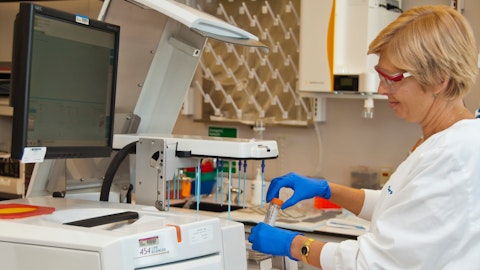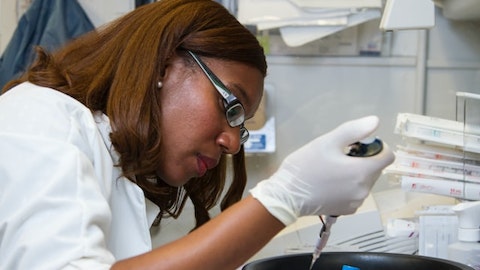Howard Robin: Mary, why don’t you take the first part and I’ll take the second part.
Mary Tagliaferri: Yeah, I definitely think that as we extend our induction period from 12 weeks to 16 weeks, I think we’re going to see a greater number of patients experience a deeper response. So I very much look forward to seeing what the mean percent change is. As you know, our EASI mean percent change from baseline to 12 weeks was 83%. And as such, that was greater than any of the biologic agents, if you look at Dupi, or Adbry, or Lebri, or Nemo or Roca [ph], we definitely saw the deepest response. But I do believe that we’ll probably see more patients, who experience an EASI-75 and even an EASI-90 as we go out in additional 4 weeks in the induction period.
Howard Robin: With regard to Lilly, Lilly after we filed our complaint in federal courts, Lilly tried to convince the federal court judge, who dismiss the case as you know. And last week the federal judge refused Lilly’s request and the judge agreed to allow Nektar’s primary claims to move forward and we expect the judge to settle trial date in 2025. The court also ordered the parties to engage in mediation within the next 3 months to try to resolve the issue. And so, we’re very, very happy the case is moving forward. The judge did not dismiss the case and we look forward to vindicating ourselves through the litigation process.
Julian Harrison: Excellent. Thanks very much.
Operator: Thank you. [Operator Instructions] And our next question will come from Andy Hsieh from William Blair. Your line is open.
Andy Hsieh: Great. Thanks for taking our questions. Two quick ones for us. One is, can you talk about this ebb and flow dynamic associated with hair loss in alopecia would enrolling kind of severe and really severe patients’ kind of mitigate that variability? And the second question has to do with the TNF receptor 165 program. We know that the receptor family is a trimer, so I guess to maximally agonize this receptor, you might have to have like a trimmer design. I’m just curious if that’s kind of a part of the design that goes into 165. And downstream from that, there’s also kind of clustering. So is that also a part of the design of the molecule? Thanks.
Howard Robin: Mary, do you want to take the hair loss? And then, JZ, you can take the TNF?
Mary Tagliaferri: Yeah. Hi, Andy, it’s Mary. So you’re exactly right. Once patients go into the severe and the very severe, generally speaking, who’s there is not a regrowth of the hair, and you’re exactly right, that’s why the eligibility criteria and even the threshold for approval by the FDA is this patient population. It does patients do start out with experiencing just patchy hair loss. But as the disease progresses, certainly the hair becomes more extreme and even towards baldness. But once a patient loses their hair, it’s very unusual for them to have regrows of their hair without some sort of medical intervention. And then I’ll pass over the second question to JZ.
Jonathan Zalevsky: Yeah. Thanks, Mary. And thanks, Andy, for your question. So you’re right, so TNF proteins are trimers. But as we’ve learned more and more about the biophysics of the receptors and the way the plaid domains, right, which are the cysteine-rich domains that hold together the receptor subunits, they actually work to create dimers [ph] of receptors. And then a trimer comes along cluster six receptors or three pairs of dimers. And then you can get additional clustering and some of this ultra-structure has been published and sub-structural studies have been done. Well, we’ve come to understand, A, through learning about the cell biology of these receptors, the way these dimers need to multi-merize and the ways the epitopes for binding to the receptor due to work is that the epitope is actually fundamentally important.
One of the things we discovered with NKTR-0165, it’s an epitome that has its own unique properties and it can signal in a completely cluster-independent fashion. For example, it doesn’t need FC, it doesn’t even need balancing. That’s one of things that’s really unique and highly differentiated about the antibodies that we’ve created and keeping in mind all of these ultra-structural forms of the receptor and then the different states that the receptors can occupy is obviously one of the key things that’s important for developing a successful activity.
Andy Hsieh: Thanks for the question.
Operator: Thank you. And I am showing no further questions from the phone lines, and I’d like to turn the conference back over to Howard Robin for any closing remarks.
Howard Robin: Well, thank you, everyone, for joining us today. And as we stated on our call, we really remain focused on executing the development of REZPEG in our immunology-focused research programs. I’d like to thank all of our employees for their very hard work and thank all of our shareholders new and existing for the continued support, and we look forward to providing you with updates on the progress. So stay tuned. Thanks for join us again.
Operator: Thank you. This concludes today’s conference call. Thank you for your participation. You may now disconnect. Everyone have a wonderful day.




